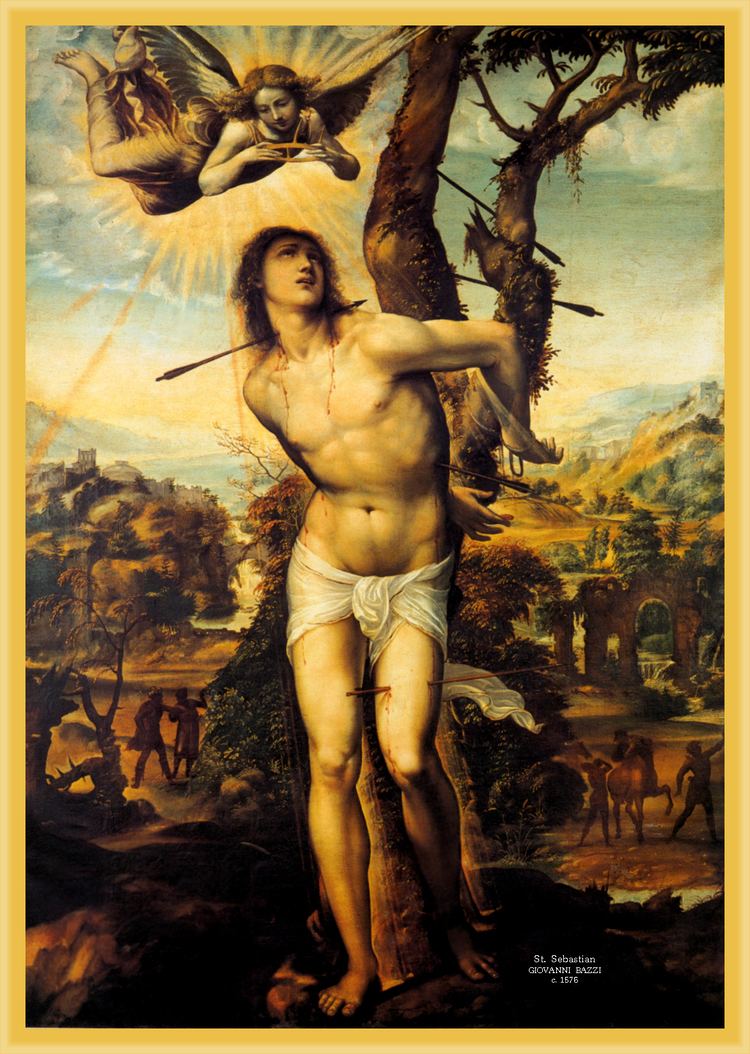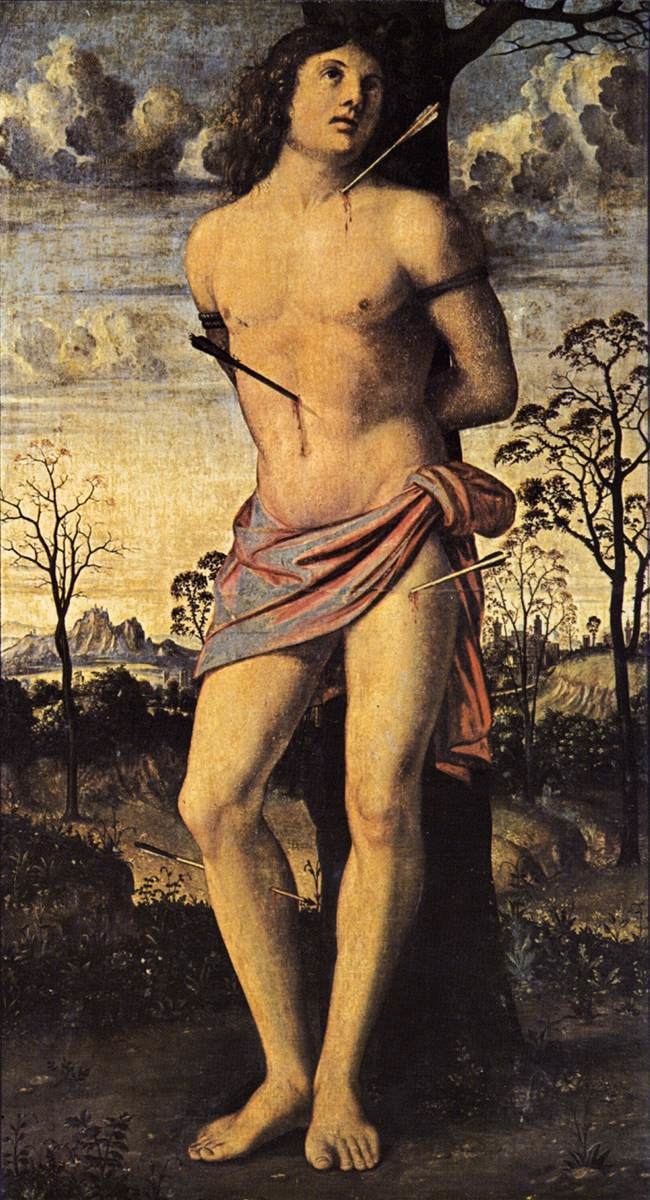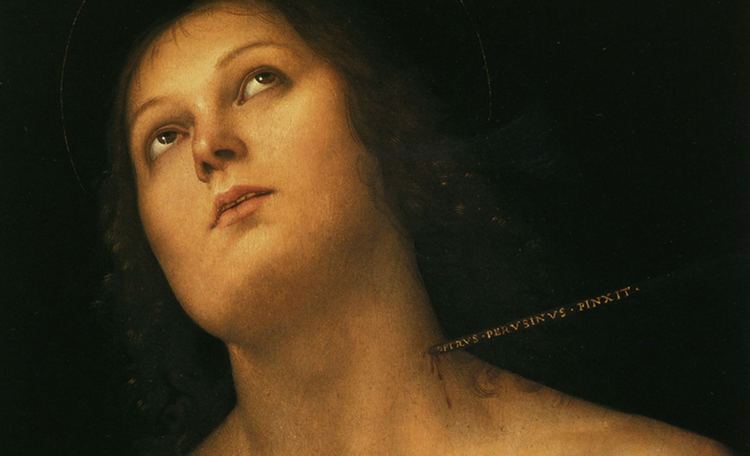Name Saint Sebastian | ||
 | ||
Venerated in Catholic ChurchEastern OrthodoxyOriental OrthodoxyAnglicanismAglipayan Church Feast January 20 (Catholic),December 18 (Eastern Orthodox) Attributes Tied to a post, pillar or a tree, shot by arrows, clubbed to death Similar People | ||
Claud Debussy - Le Martyre de Saint Sébastien
Saint Sebastian (died c. 288 AD) was an early Christian saint and martyr. According to traditional belief, he was killed during the Roman emperor Diocletian's persecution of Christians. He is commonly depicted in art and literature tied to a post or tree and shot with arrows. Despite this being the most common artistic depiction of Sebastian, he was, according to legend, rescued and healed by Irene of Rome. Shortly afterwards he went to Diocletian to warn him about his sins, and as a result was clubbed to death. He is venerated in the Roman Catholic and Orthodox Church churches.
Contents
- Claud Debussy Le Martyre de Saint Sbastien
- Who is saint sebastian
- Life
- Martyrdom
- Location of remains
- In art and literature
- Patronage
- References

The details of Saint Sebastian's martyrdom were first spoken of by 4th-century bishop Ambrose of Milan (Saint Ambrose), in his sermon (number 22) on Psalm 118. Ambrose stated that Sebastian came from Milan and that he was already venerated there at that time. Saint Sebastian is a popular male saint, especially among athletes.

Who is saint sebastian
Life

According to Sebastian's 18th-century entry in Acta Sanctorum, still attributed to Ambrose by the 17th-century hagiographer Jean Bolland, and the briefer account in the 14th-century Legenda Aurea, he was a man of Gallia Narbonensis who was taught in Milan. In 283, Sebastian entered the army in Rome under Emperor Carinus to assist the martyrs. Because of his courage he became one of the captains of the Praetorian Guards under Diocletian and Maximian, who were unaware that he was a Christian.

According to tradition, Marcus and Marcellian were twin brothers from a distinguished family and were deacons. Both brothers married, and they resided in Rome with their wives and children. The brothers refused to sacrifice to the Roman gods and were arrested. They were visited by their parents Tranquillinus and Martia in prison, who attempted to persuade them to renounce Christianity. Sebastian succeeded in converting Tranquillinus and Martia, as well as Saint Tiburtius, the son of Chromatius, the local prefect. Another official, Nicostratus, and his wife Zoe were also converted. It has been said that Zoe had been a mute for six years; however, she made known to Sebastian her desire to be converted to Christianity. As soon as she had, her speech returned to her. Nicostratus then brought the rest of the prisoners; these 16 persons were converted by Sebastian.

Chromatius and Tiburtius converted; Chromatius set all of his prisoners free from jail, resigned his position, and retired to the country in Campania. Marcus and Marcellian, after being concealed by a Christian named Castulus, were later martyred, as were Nicostratus, Zoe, and Tiburtius.
Martyrdom

Sebastian had prudently concealed his faith, but in 286 was detected. Diocletian reproached him for his supposed betrayal, and he commanded him to be led to a field and there to be bound to a stake so that certain archers from Mauritania would shoot arrows at him. "And the archers shot at him till he was as full of arrows as an urchin is full of pricks, and thus left him there for dead." Miraculously, the arrows did not kill him. The widow of Castulus, Irene of Rome, went to retrieve his body to bury it, and she discovered he was still alive. She brought him back to her house and nursed him back to health.

Sebastian later stood by a staircase where the emperor was to pass and harangued Diocletian for his cruelties against Christians. This freedom of speech, and from a person whom he supposed to have been dead, greatly astonished the emperor; but, recovering from his surprise, he gave orders for his being seized and beat to death with cudgels, and his body thrown into the common sewer. A pious lady, called Lucina, admonished by the martyr in a vision, privately removed the body, and buried it in the catacombs at the entrance of the cemetery of Calixtus, where now stands the Basilica of St. Sebastian.
Sebastian was said to be a defense against the plague. The Golden Legend transmits the episode of a great plague that afflicted the Lombards in the time of King Gumburt, which was stopped by the erection of an altar in honor of Sebastian in the Church of Saint Peter in the Province of Pavia.
Location of remains
Remains reputed to be those of Sebastian are housed in Rome in the Basilica Apostolorum, built by Pope Damasus I in 367 on the site of the provisional tomb of Saints Peter and Paul. The church, today called San Sebastiano fuori le mura, was rebuilt in the 1610s under the patronage of Scipione Borghese.
St. Ado, Eginard, Sigebert, and other contemporary authors relate that, in the reign of Louis Debonnair, Pope Eugenius II gave the body of St. Sebastian to Hilduin, Abbot of St. Denys, who brought it into France, and it was deposited at Saint Medard Abbey, at Soissons, on the 8th of December, in 826.
Sebastian's cranium was brought to the town of Ebersberg (Germany) in 934. A Benedictine abbey was founded there and became one of the most important pilgrimage sites in southern Germany. It is said the silver-encased cranium was used as a cup in which to present wine to the faithful during the feast of Saint Sebastian.
In art and literature
The earliest representation of Sebastian is a mosaic in the Basilica of Sant'Apollinare Nuovo (Ravenna, Italy) dated between 527 and 565. The right lateral wall of the basilica contains large mosaics representing a procession of 26 martyrs, led by Saint Martin and including Sebastian. The martyrs are represented in Byzantine style, lacking any individuality, and all have identical expressions.
Another early representation is in a mosaic in the Church of San Pietro in Vincoli (Rome, Italy), probably made in the year 682. It shows a grown, bearded man in court dress but contains no trace of an arrow. The archers and arrows begin to appear by 1000, and ever since have been far more commonly shown than the actual moment of his death by clubbing, so that there is a popular misperception that this is how he died.
As protector of potential plague victims (a connection popularized by the Golden Legend) and soldiers, Sebastian occupied an important place in the popular medieval mind. He was among the most frequently depicted of all saints by Late Gothic and Renaissance artists, in the period after the Black Death. The opportunity to show a semi-nude young male, often in a contorted pose, also made Sebastian a favourite subject. His shooting with arrows was the subject of the largest engraving by the Master of the Playing Cards in the 1430s, when there were few other current subjects with male nudes other than Christ. Sebastian appears in many other prints and paintings, although this was due to his popularity with the faithful. Among many others, Botticelli, Perugino, Titian, Pollaiuolo, Giovanni Bellini, Guido Reni (who painted the subject seven times), Mantegna (three times), Hans Memling, Gerrit van Honthorst, Luca Signorelli, El Greco, Honoré Daumier, John Singer Sargent and Louise Bourgeois all painted Saint Sebastians. An early work by the sculptor Gianlorenzo Bernini is of Saint Sebastian.
The saint is ordinarily depicted as a handsome youth pierced by arrows. Predella scenes when required, often depicted his arrest, confrontation with the Emperor, and final beheading. The illustration in the infobox is the Saint Sebastian of Il Sodoma, at the Pitti Palace, Florence.
A mainly 17th-century subject, though found in predella scenes as early as the 15th century, was St Sebastian tended by St Irene, painted by Georges de La Tour, Trophime Bigot (four times), Jusepe de Ribera, Hendrick ter Brugghen (in perhaps his masterpiece) and others. This may have been a deliberate attempt by the Church to get away from the single nude subject, which is already recorded in Vasari as sometimes arousing inappropriate thoughts among female churchgoers. The Baroque artists usually treated it as a nocturnal chiaroscuro scene, illuminated by a single candle, torch or lantern, in the style fashionable in the first half of the 17th century. There exist several cycles depicting the life of Saint Sebastian. Among them are the frescos in the "Basilica di San Sebastiano" of Acireale (Italy) with paintings by Pietro Paolo Vasta.
Egon Schiele, an Austrian Expressionist artist, painted a self-portrait as Saint Sebastian in 1915. During Salvador Dalí's "Lorca (Federico García Lorca) Period", he painted Sebastian several times, most notably in his "Neo-Cubist Academy".
In 1911, the Italian playwright Gabriele d'Annunzio in conjunction with Claude Debussy produced a mystery play on the subject. The American composer Gian Carlo Menotti composed a ballet score for a Ballets Russes production which was first given in 1944. In his novella Death in Venice, Thomas Mann hails the "Sebastian-Figure" as the supreme emblem of Apollonian beauty, that is, the artistry of differentiated forms; beauty as measured by discipline, proportion, and luminous distinctions. This allusion to Saint Sebastian's suffering, associated with the writerly professionalism of the novella's protagonist, Gustav Aschenbach, provides a model for the "heroism born of weakness", which characterizes poise amidst agonizing torment and plain acceptance of one's fate as, beyond mere patience and passivity, a stylized achievement and artistic triumph.
In George Orwell's futuristic novel Nineteen Eighty-Four, the protagonist Winston Smith, at the time he is not aware she actually loves him and hates the Party, is said to have dreams of ravishing the girl Julia, and having her pierced through with arrows like Saint Sebastian.
Sebastian's death was depicted in the 1949 film Fabiola, in which he was played by Massimo Girotti. In 1976, the British director Derek Jarman made a film, Sebastiane, which caused controversy in its treatment of the martyr as a "homosexual icon", according to a number of critics reflecting a subtext perceptible in the imagery since the Renaissance. Also in 1976, in the American horror film Carrie, a figure of Saint Sebastian (commonly misconstrued as a figure of the crucified Christ) appears in Carrie's prayer closet.
Additionally in 1976, a depiction of Saint Sebastian in a fresco restoration in an isolated Italian village is the central motif and cryptic mystery of the giallo horror film The House with Laughing Windows
In 1990's The Godfather Part III, Michael Corleone is awarded the Order of Saint Sebastian, said by some sources to be fictitious.
Pietro Vannucci Perugino’s painting (c. 1495) of Saint Sebastian is featured in the 2001 movie Wit starring Emma Thompson. Thompson’s character, as a college student, visits her professor's office, where an almost life-size painting of Saint Sebastian hangs on the wall. Later, when the main character is a professor herself, diagnosed with cancer, she keeps a small print of this same painting of Saint Sebastian next to her hospital bed. The allusion appears to be to Sebastian's stoic martyrdom - a role the Thompson character has willingly accepted for the betterment of all mankind. There may be a touch of authorial (or directorial) cynicism in making this "saintly" connection.
In 2007, artist Damien Hirst presented Saint Sebastian, Exquisite Pain from his Natural History series. The piece depicts a cow in formaldehyde, bound in metal cable and shot with arrows.
British pop band Alt-J's video for Hunger of the Pine contains references to the story of Saint Sebastian's death, adapted to fit the lyrics of the song. Tarsem Singh's video for the R.E.M. song "Losing My Religion" makes use of imagery of St. Sebastian, drawing particular inspiration from paintings by Guido Reni and Caravaggio. The indie folk band the Mountain Goats have a song called "Hail, St. Sebastian" which makes reference to his life.
Patronage
In the Roman Catholic Church, Sebastian is commemorated by an optional memorial on 20 January. In the Church of Greece, Sebastian's feast day is on 18 December.
As a protector from the bubonic plague, Sebastian was formerly one of the Fourteen Holy Helpers. The connection of the martyr shot with arrows with the plague is not an intuitive one, however. In Greco-Roman myth, Apollo, the archer god, is the deliverer from pestilence; the figure of Sebastian Christianizes this folkloric association. The chronicler Paul the Deacon relates that, in 680, Rome was freed from a raging pestilence by him.
In Catholicism, Sebastian is the patron saint of archers, athletes, and of a holy death.
Sebastian is one of the patron saints of the city of Qormi in Malta along with Saint George. Sebastian is the patron saint of Acireale, Caserta and Petilia Policastro in Italy, Melilli in Sicily, and San Sebastián as well as Palma de Mallorca and Huelva in Spain. He is the patron saint of Rio de Janeiro, Brazil. Informally, in the tradition of the Afro-Brazilian syncretic religion Umbanda, Sebastian is often associated with Oxossi, especially in the state of Rio de Janeiro itself.
Feast of St. Sebastian is celebrated among Catholic communities of Kerala in India, with lot of elegance and colour. Churches are grandiosely illuminated and decorated, with fireworks being a main event in every Catholic home to commemorate the saint. Every parish has its own date of celebration, especially in the districts of Thrissur, Ernakulam, Alapuzha and Kottayam. Besides this, many pilgrim centres, churches, shrines and many educational institutions too, throughout Kerala, bear the name of the saint.
He is the patron of a college named for him in Manila, Philippines which is adjacent to the Parish of San Sebastian.
Sebastian is the patron saint of the Roman Catholic Diocese of Bacolod, in Negros Occidental, Philippines.
Saint Sebastian is the patron of Knights of Columbus Council #4926 in the Roman Catholic Diocese of San Jose in California, serving the cities of Mountain View and Los Altos.
Saint Sebastian is the patron saint of the Catholic War Veterans of the United States of America. The highest award given by the CWV is the Honor Legion of the Order of St. Sebastian.
In his 1906 Reminiscences, Carl Schurz recalls the annual "bird shoot" pageant of the Rhenish town of Liblar which was sponsored by the Saint Sebastian Society, a club of sharpshooters and their sponsors to which nearly every adult member of town belonged.
The St. Sebastian River is named after him. It is a tributary of the Indian River Lagoon and comprises part of the boundary between Indian River County and Brevard County in Florida. The adjacent city of Sebastian, Florida and St. Sebastian River Preserve State Park are also named for Saint Sebastian.
